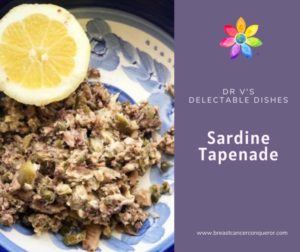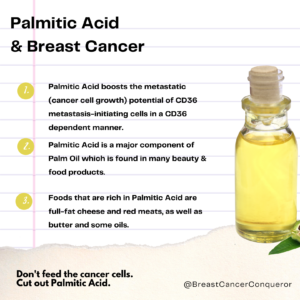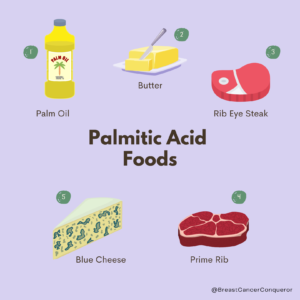At a Glance:
- A protein called CD36, found in cell membranes of tumor cells, is responsible for taking up fatty acids (Palmitic Acid). It is a general marker of metastatic cells.
- Some foods that contain Palmitic Acid are full-fat cheese, meats, and some oils.
- Cutting out Palmitic Acid from your diet can prevent the spread of cancer cells.
- Recipes to try Sardine Tapenade [1].
- ProductsWithoutPalmOil.com [2] is a great website to research home, skin, and food products free of palm oil.
What does Palmitic Acid have to do with Breast Cancer?
New research shows [3] that the metastatic process (cancer spread) is enhanced by fat intake. This study identifies for the first time a protein called CD36, which has an essential role in cancer spreading. CD36 is responsible for taking up fatty acids. Its dependence on fatty acids distinguishes metastasis-initiating cells from other tumor cells.
In this 2016 study on mice, the mice given a high-fat diet, including Palmitic Acid, developed the most aggressive cancer spread. The team managing the study also found that CD36 was present on metastatic cancer cells in human patients with various tumors. These tumors included melanoma skin cancer, ovarian, lung, bladder, and breast cancer.
“We can state that CD36 is a general marker of metastatic cells, the first I know of that is generally specific to metastasis,” says Professor Benitah, Head of the Stem Cell and Cancer Lab at IRB Barcelona and head of the Worldwide Cancer Research study [3]. “We expect this study to have a big impact on the scientific community and to further advances in metastasis research, and we hope to be able to validate the potential of CD36 as an anti-metastasis treatment. Things like this don’t happen every day.”
The results of the study above were further researched in other studies. A Journal of Cellular Physiology [4] study states, “Most breast and other cancer cell types are addicted to fatty acids (FA), which they require for membrane phospholipid synthesis, signaling purposes, and energy production.”
A study by Nature [5] found that “Palmitic Acid or a high-fat diet specifically boosts the metastatic potential of CD36+ metastasis-initiating cells in a CD36-dependent manner. The use of neutralizing antibodies to block CD36 causes almost complete inhibition of metastasis in immunodeficient or immunocompetent mouse models of human oral cancer, with no side effects.”
All of this to say, fatty acids such as Palmitic Acid (palm oil), help spread cancer cells.
What is Palmitic Acid?
Let’s start with some history. Palmitic Acid is also known as hexadecanoic acid (16 carbon atoms). It is the most common saturated fatty acid found in animals, plants, and microorganisms. In 1840 Edward Frémy first studied it in saponified palm oil, from which Palmitic Acid got its name. It is a major component of palm oil which is sadly found in many beauty products and foods.
Palmitic Acid Products
Palmitic Acid is found in many skincare and cosmetic formulations. It improves the texture of products and helps trap moisture in the skin. The human body also naturally creates Palmitic Acid. When our body contains an excess of carbohydrates it converts them into Palmitic Acid and then stores them as fat. The stratum corneum of the skin also contains Palmitic Acid. It is the upper layer of the skin that is held by the natural oils our skin produces. This layer protects the skin from moisture loss, bacteria, and allergens.
When searching for skincare products, try to find products that do not contain palm oil, Palmitic Acid, or its other name of hexadecanoic acid. For those of us healing and preventing cancer, this is not something we need to be lathering all over our porous skin that seeps throughout our bodies.
Additionally, palm oil harvesting contributes significantly to deforestation, threatening biodiversity and wildlife. Usually, if something is bad for our planet, it is bad for you!
Palmitic Acid Foods
Some foods that contain Palmitic Acid are:
- Full-fat cheese (cheddar, Swiss, blue cheese, etc.)
- Butter
- High-fat red meat (rib eye, NY strip, prime rib. etc.)
- Some oils: palm, corn, soy, and sunflower
ProductsWithoutPalmOil.com [8] is a great website to research home, skin, and food products free of palm oil.
Recommended Foods to Eat
To counter, here are some alternative foods that contain heart-healthy and cancer-fighting fats.
- Nuts and seeds (almonds, walnuts, cashews, pumpkin and apricot seeds, etc.) are also high in protein and fiber and an excellent source of healthy fat. Nuts are truly superfoods on your Healthy Breast journey. Learn more about them here [9]!
- Olive oil olives should be a staple in your kitchen. It is a good source of monounsaturated fat [10], which studies have shown could reduce a woman’s risk of breast cancer. Researchers have also discovered that an ingredient found in the oil─ oleocanthal─can kill cancer cells [11]. Oleocanthal is a compound that ruptures a part of the cancer cell wall. On top of the cancer-killing benefits, olive oil is anti-bacterial, can reduce inflammation, and it contains a plethora of vitamins and nutrients. When choosing an olive oil to add to your pantry, make sure it is organic, cold-pressed, and extra virgin olive oil (EVOO). The greener the better for extra freshness and purity. Moderate amounts of monounsa
 turated fats are an important part of the “7 Essentials System™ [12]” for healing the body naturally and healthy. An organic extra virgin olive oil should be a part of every healthy breast diet protocol.
turated fats are an important part of the “7 Essentials System™ [12]” for healing the body naturally and healthy. An organic extra virgin olive oil should be a part of every healthy breast diet protocol. - Omega-3 fatty acids is a fatty acid that I highly recommend! It can be found in a supplement [13], walnuts, chia seeds, sardines,salmon, etc. “Omega-3 PUFAs [14] play essential roles in cell signaling and in the cell structure and fluidity of membranes. They participate in the resolution of inflammation and have anti-inflammatory and antinociceptive effects.” I order my sardines from safecatch.com [15], and if you use code “DRV” at checkout you will get 20% off your first order!Use them in this delectable Sardine Tapenade [1]. It will change your outlook on sardines!

